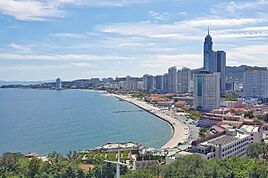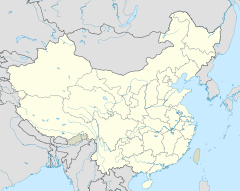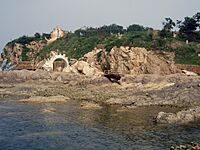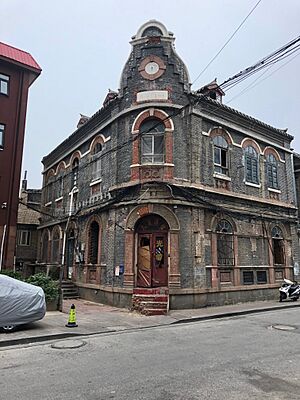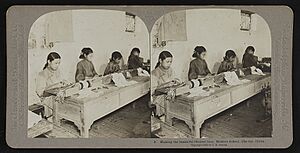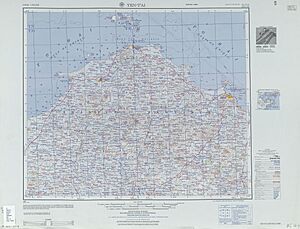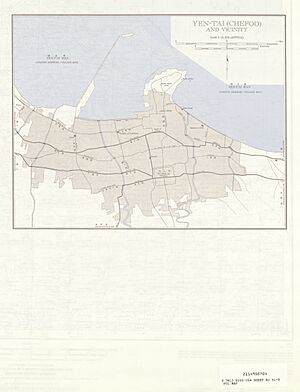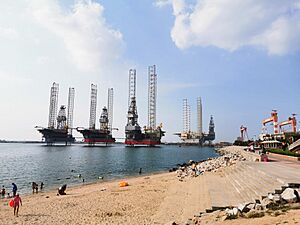Yantai facts for kids
Quick facts for kids
Yantai
烟台市
Yentai
|
|
|---|---|
|
Prefecture-level city
|
|
|
From top, left to right: Yantai Skyline; Port in Longkou; Yantai Mountain; Three Harmony Taoism Pagoda, Taishan; Tianhou Temple; Moon Bay
|
|
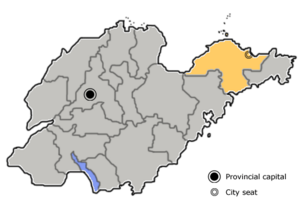
Location of Yantai City Jurisdiction in Shandong
|
|
| Country | People's Republic of China |
| Province | Shandong |
| County-level divisions | 12 |
| Townships-level divisions | 148 |
| Settled as a barrack | 1398 |
| Open as a trade port (CHEFOO) | 22 August 1861 |
| Settled as a city | 19 January 1938 |
| Settled as a prefecture level city | 30 August 1983 |
| Municipal seat | Laishan District |
| Area | |
| • Prefecture-level city | 13,739.9 km2 (5,305.0 sq mi) |
| Population
(2023 census)
|
|
| • Prefecture-level city | 7,102,100 |
| • Density | 516.896/km2 (1,338.755/sq mi) |
| • Urban | 4,233,100 |
| • Metro | 2,264,554 |
| GDP | |
| • Prefecture-level city | CN¥ 1.0162 trillion US$ 147.176 billion |
| • Per capita | CN¥ 143,971 US$ 20,254.54 |
| Time zone | UTC+8 (China Standard) |
| Postal code |
264000-265800
|
| Area code(s) | 535 |
| ISO 3166 code | CN-SD-06 |
| License Plate | 鲁F & 鲁Y |
| Yantai | |||||||||||
|---|---|---|---|---|---|---|---|---|---|---|---|
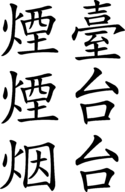
"Yantai" in Chinese
|
|||||||||||
| Simplified Chinese | 烟台 | ||||||||||
| Traditional Chinese | 煙臺 煙台 |
||||||||||
| Hanyu Pinyin | Yāntái | ||||||||||
| Literal meaning | "Smoke Tower" | ||||||||||
|
|||||||||||
| Former names | |||||||
|---|---|---|---|---|---|---|---|
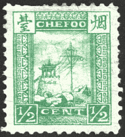
A Qing-era postage stamp from Zhifu ("Chefoo")
|
|||||||
| Zhifu | |||||||
| Chinese | 芝罘 | ||||||
| Hanyu Pinyin | Zhīfú | ||||||
| Postal | Chefoo | ||||||
|
|||||||
Yantai, once known as Chefoo, is a big coastal city in Shandong province, China. It sits on the Shandong Peninsula, next to the Bohai Strait. Yantai is near Qingdao to the southwest and Weihai to the east. It has access to both the Bohai Sea and the Yellow Sea.
Yantai is the largest fishing port in Shandong. In 2020, about 7.1 million people lived there. Over 3.1 million of them lived in the main city areas. These areas include the districts of Zhifu, Laishan, Fushan, Muping, and Penglai.
Contents
What's in a Name?
The name Yantai means "Smoke Tower". It comes from watchtowers built in 1398 on Mount Qi. These towers were used to send smoke signals. This was during the Ming dynasty, when the area faced attacks from pirates. The city was also called Yen-tai in the past.
The main part of Yantai is called Zhifu. Foreigners used to call the whole city "Chefoo". But local people always called it Yantai.
Yantai's Story
Long ago, during the Xia and Shang times, local people lived here. Later, the area became part of the state of Qi. In 567 BC, Qi took over the area. Over many centuries, the region changed names and rulers many times.
Before the 1800s, Zhifu was just small fishing villages. The Ming rulers had a "Sea Ban." This rule stopped coastal Chinese from trading and fishing. It made people move inland.
After the Second Opium War, China had to open more ports for trade. Zhifu became an important international port in 1861. Many countries, like Britain, set up offices there. The city grew with new streets and buildings. Churches and a large hotel were built. Foreigners liked to visit Yantai in the summer.
British and American traders were the main ones. They traded goods like wool, cotton, and iron. Yantai exported local foods like tofu and vegetables. It also sent out raw silk and walnuts. The city was a good place for foreign ships to get coal.
In 1876, a special agreement called the Chefoo Convention was signed here. This agreement gave British people special rights in China. It also helped foreign businesses.
Chefoo became known for its beautiful bobbin lace. British missionaries brought this craft to the area. Chefoo lace was even shown at the 1904 World's Fair in St. Louis.
Germany also had economic ties with Yantai for about 20 years. After World War I, Japan took over Yantai. They used it as a summer base for their navy. The Yantai Museum now shows the city's history.
In 1949, the city's name officially changed from Chefoo to Yantai. In 1984, it became an open trade port. Yantai is important for China's defense. It guards the coast along with Dalian. In 1983, Yantai became a "prefecture-level city."
Where is Yantai?
Yantai is on the north coast of the Shandong Peninsula. It is south of where the Bohai Sea and Yellow Sea meet. The land in Yantai is varied:
- 36.62% is mountains.
- 39.7% is hills.
- 50.23% is flat plains.
- 2.90% is basins.
About 2,643.60 square kilometers of the city is urbanized. Only Qixia City is completely inland. All other areas are on the coast. The total coastline is 909 kilometers long.
The hills are usually 100 to 300 meters high. Mountains average 500 meters. The highest point is Mount Kunyu, at 922.8 meters.
Yantai has 121 rivers longer than 5 kilometers. The biggest ones include the Wulong River and the Dagu River.
Weather in Yantai
Yantai has a climate affected by monsoons. Summers are hot, wet, and rainy. Winters are cold and dry. The temperature can go from -12.8°C in winter to 38°C in summer.
| Climate data for Yantai (1991–2020 normals, extremes 1971–2010) | |||||||||||||
|---|---|---|---|---|---|---|---|---|---|---|---|---|---|
| Month | Jan | Feb | Mar | Apr | May | Jun | Jul | Aug | Sep | Oct | Nov | Dec | Year |
| Record high °C (°F) | 15.5 (59.9) |
19.8 (67.6) |
26.5 (79.7) |
33.6 (92.5) |
35.8 (96.4) |
38.0 (100.4) |
37.0 (98.6) |
36.2 (97.2) |
35.1 (95.2) |
30.4 (86.7) |
26.0 (78.8) |
18.8 (65.8) |
38.0 (100.4) |
| Mean daily maximum °C (°F) | 2.4 (36.3) |
4.7 (40.5) |
10.8 (51.4) |
17.5 (63.5) |
23.5 (74.3) |
26.9 (80.4) |
28.8 (83.8) |
28.5 (83.3) |
25.3 (77.5) |
19.6 (67.3) |
12.1 (53.8) |
4.8 (40.6) |
17.1 (62.7) |
| Daily mean °C (°F) | −0.9 (30.4) |
0.9 (33.6) |
6.0 (42.8) |
12.4 (54.3) |
18.5 (65.3) |
22.3 (72.1) |
25.2 (77.4) |
25.3 (77.5) |
21.7 (71.1) |
15.7 (60.3) |
8.5 (47.3) |
1.6 (34.9) |
13.1 (55.6) |
| Mean daily minimum °C (°F) | −3.4 (25.9) |
−1.9 (28.6) |
2.4 (36.3) |
8.4 (47.1) |
14.4 (57.9) |
18.9 (66.0) |
22.4 (72.3) |
22.8 (73.0) |
18.9 (66.0) |
12.6 (54.7) |
5.6 (42.1) |
−1.0 (30.2) |
10.0 (50.0) |
| Record low °C (°F) | −12.8 (9.0) |
−12.6 (9.3) |
−8.1 (17.4) |
−2.6 (27.3) |
6.6 (43.9) |
11.5 (52.7) |
14.7 (58.5) |
15.0 (59.0) |
10.7 (51.3) |
0.8 (33.4) |
−4.9 (23.2) |
−10.8 (12.6) |
−12.8 (9.0) |
| Average precipitation mm (inches) | 15.5 (0.61) |
13.8 (0.54) |
16.9 (0.67) |
38.3 (1.51) |
52.1 (2.05) |
65.5 (2.58) |
160.1 (6.30) |
143.9 (5.67) |
56.7 (2.23) |
27.8 (1.09) |
35.1 (1.38) |
24.4 (0.96) |
650.1 (25.59) |
| Average precipitation days (≥ 0.1 mm) | 6.4 | 4.5 | 4.0 | 5.4 | 6.8 | 7.9 | 10.6 | 10.1 | 6.1 | 5.6 | 5.5 | 8.0 | 80.9 |
| Average snowy days | 10.9 | 6.5 | 2.4 | 0.2 | 0 | 0 | 0 | 0 | 0 | 0 | 2.4 | 10.9 | 33.3 |
| Average relative humidity (%) | 61 | 59 | 53 | 53 | 58 | 69 | 80 | 81 | 70 | 62 | 61 | 61 | 64 |
| Mean monthly sunshine hours | 156.0 | 174.2 | 233.5 | 240.4 | 267.7 | 244.1 | 202.0 | 215.4 | 217.0 | 202.8 | 163.4 | 141.7 | 2,458.2 |
| Percent possible sunshine | 51 | 57 | 63 | 61 | 61 | 56 | 46 | 52 | 59 | 59 | 54 | 48 | 56 |
| Source 1: China Meteorological Administration | |||||||||||||
| Source 2: Weather China | |||||||||||||
How Yantai is Organized
Yantai is a prefecture-level city. It has 12 smaller areas called county-level divisions. These include 5 districts and 6 cities. There is also one special development zone.
- Zhifu District (芝罘区)
- Fushan District (福山区)
- Muping District (牟平区)
- Laishan District (莱山区)
- Penglai District (蓬莱区)
- Laiyang City (莱阳市)
- Laizhou City (莱州市)
- Zhaoyuan City (招远市)
- Qixia City (栖霞市)
- Haiyang City (海阳市)
- Longkou City (龙口市)
- Yantai Economic and Technological Development Zone
- Yantai Hi-tech Industrial Development Zone
These areas are further divided into 148 smaller parts. These include 94 towns, 6 townships, and 48 subdistricts.
| Map |
|---|
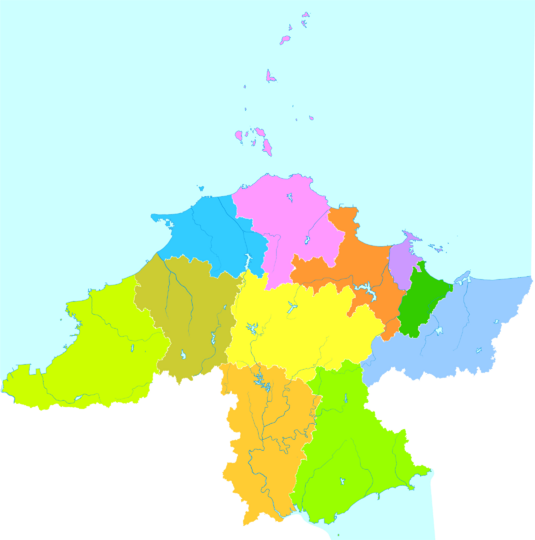
Zhifu
Fushan
Muping
Laishan
Penglai
Longkou
(city) Laiyang
(city) Laizhou
(city) Zhaoyuan
(city) Qixia
(city) Haiyang
(city) |
Yantai's Economy
Yantai is the second largest industrial city in Shandong. However, farming is the biggest industry here. Yantai is famous for its special apples and Laiyang pears. It also has China's oldest and largest grape winery, Changyu.
The city of Longkou is well known for making cellophane noodles.
Energy in Yantai
Yantai gets most of its energy from a large coal power plant. This plant uses special technology to reduce pollution. The city of Haiyang plans to use nuclear power for all its winter heating by 2021.
Industrial Areas
Yantai Economic and Technological Development Area
This is one of China's first special economic development zones. It covers 10 square kilometers and has 115,000 people. It is close to Yantai Port and the railway station.
Yantai Export Processing Zone
This zone helps companies that make goods for export. It has attracted businesses from Japan, Korea, Singapore, and other countries. It has good facilities like warehouses.
Learning in Yantai
Here are some of the main universities in Yantai:
- Yantai University
- Ludong University
- Shandong Institute of Business and Technology
Some other universities, like China Agricultural University, also have campuses here. There is a Korean School in Yantai for international students.
Getting Around Yantai
Yantai Penglai International Airport has flights to major cities in China. It also has flights to Seoul, Osaka, and Hong Kong. The Lancun–Yantai railway ends in Yantai.
The Qinggrong Intercity Railway is a high-speed train. It connects Qingdao to Yantai much faster. A trip that used to take 4 hours and 30 minutes now takes about 1 hour and 15 minutes.
Fun Places to Visit
In Penglai City, about 80 km from Yantai, you can find Dan Cliffs. People say this is where the Eight Immortals started their journey to the Magical Peach Conference.
Yangma Island is in the north of Muping District. It has nice weather all year round. It's a great place for holidays. Some even call it the "Maldives of China." Long ago, Emperor Qin Shi Huang reportedly raised royal horses here. That's how it got its name, which means "Royal Horse Island."
Cities Yantai is Friends With
Yantai has "sister city" relationships with many cities around the world:
| Country | City |
|---|---|
| Brazil | Vitória |
| United States | San Diego |
| Japan | Beppu |
| New Zealand | Tauranga |
| Japan | Miyako |
| South Korea | Gunsan |
| Thailand | Phuket |
| United Kingdom | Angus |
| South Korea | Wonju |
| South Korea | Ulsan |
| Sweden | Örebro |
| Bulgaria | Burgas |
| France | Quimper |
| France | Angers |
| South Korea | Incheon |
| South Korea | Ansan |
| United States | Omaha |
| Australia | Mackay |
| Spain | Alcala De Henares |
| Hungary | Miskolc |
Famous People from Yantai
- Qiu Chuji (1148–1227), a famous Taoist priest.
- Qi Jiguang (1528–1588), a Ming dynasty general who fought pirates.
- Wang Yirong (1845–1900), a historian who first found ancient oracle bone writings.
- Henry Luce (1898–1967), who started Time Magazine and Life Magazine.
- Peter Stursberg (1913–2014), a Canadian writer and journalist.
- Chou Wen-chung (1923–2019), a composer.
- Lin Qingxia (born 1954), an actress.
- Wang Yaping (born 1980), an astronaut.
- Fan Bingbing (born 1981), an actress.
- Guanqun Yu (born 1982), an opera singer.
- Zhao Yingzi (born 1990), an actress.
See also
 In Spanish: Yantai para niños
In Spanish: Yantai para niños


